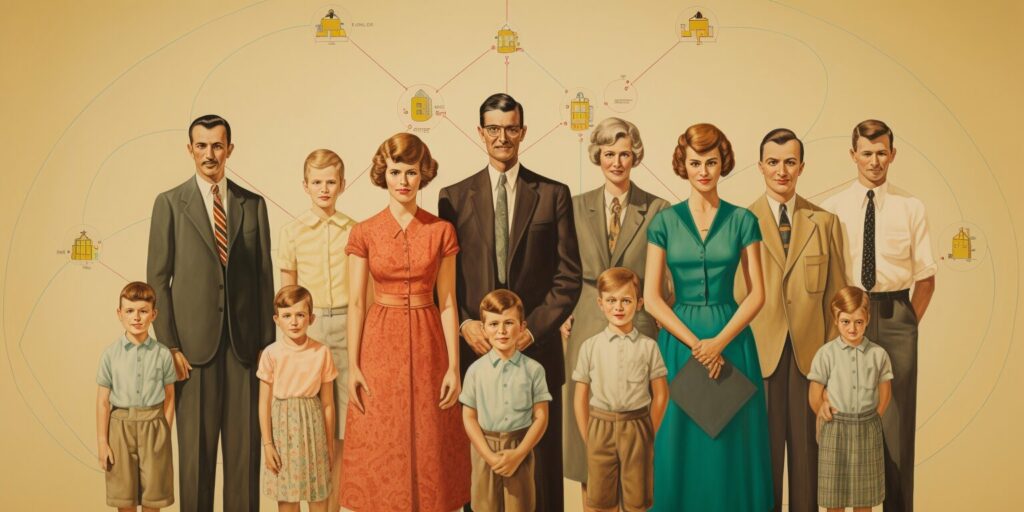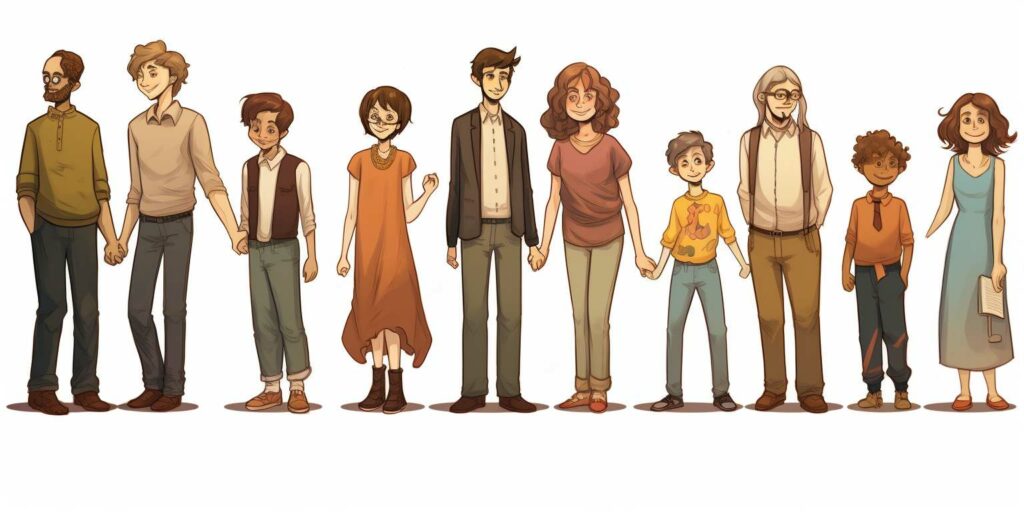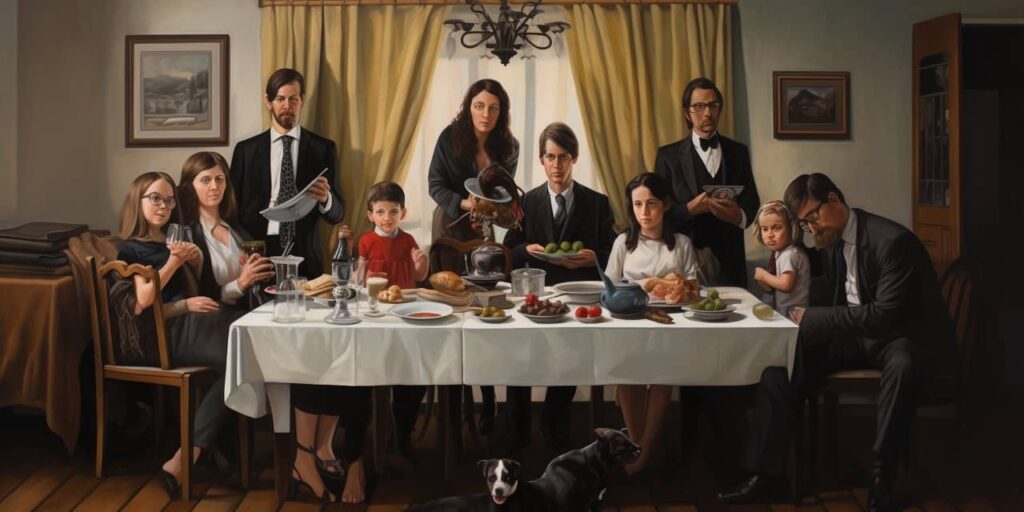The nuclear family, also known as the traditional family, is a term used to describe a family unit consisting of a married couple and their biological or adopted children living together under one roof. It is considered the fundamental building block of society and has been prevalent in many cultures across the world.
Nowadays, the concept of the nuclear family has evolved to some extent, with variations such as single-parent households or blended families becoming more common. However, at its core, the nuclear family still represents the idea of a tight-knit unit where parents assume primary responsibility for raising their children.
While there may be debates about the ideal family structure or whether it is still relevant in today’s society, understanding what constitutes a nuclear family helps us appreciate its historical significance and how it has shaped our social norms and values. Let’s delve deeper into this topic to understand what defines a nuclear family and its role within our communities.
Defining the Nuclear Family
Let’s delve into what exactly a nuclear family is. The term “nuclear family” refers to a social unit composed of parents and their children living together in one household. It typically consists of a married heterosexual couple and their biological or adopted children. This type of family structure has been widely recognized as the traditional model in many societies.
The nuclear family often forms the foundation of our society, providing emotional support, stability, and guidance for its members. It serves as a nurturing environment where children learn important values, develop strong bonds with their parents, and acquire essential life skills. Within this intimate setting, parents play vital roles as caregivers, role models, and educators.
Though the concept of the nuclear family may seem straightforward at first glance, it can take on various forms depending on cultural norms and individual circumstances. For instance, single-parent households or families with same-sex parents also fall under the umbrella of nuclear families. In these cases, one parent assumes both parental roles, or couples rely on alternative means such as surrogacy or adoption to start their families.
It’s worth noting that the prevalence of nuclear families has undergone significant changes over time due to shifting societal dynamics. Factors such as increased divorce rates, cohabitation before marriage, and changing attitudes toward marriage have led to diverse household structures emerging within communities.
In conclusion, while there is no universally fixed definition for the nuclear family concept anymore, given its evolution over time, its fundamental essence remains intact – a close-knit unit comprising parents and their children sharing love and responsibilities and navigating life’s challenges together.
Historical Context of the Nuclear Family
To truly understand the nuclear family concept, it is crucial to explore its historical context. The nuclear family has been a predominant social unit in many societies throughout history, but its structure and dynamics have evolved over time. Here are some key points to consider:
- Ancient Civilizations:
- In ancient civilizations such as Egypt and Mesopotamia, the nuclear family was often extended to include multiple generations living under one roof.
- Patriarchal systems were prevalent, with men being the heads of households and responsible for providing for their families.
- Medieval Europe:
- Feudalism shaped the structure of families during medieval times. Families were tied to the land they worked on and formed tight-knit communities.
- The nuclear family consisted of parents and their children working together to support themselves.
- Industrial Revolution:
- The Industrial Revolution brought about significant changes in family dynamics as people migrated from rural areas to cities in search of work.
- Due to urbanization and economic factors, families became smaller. The focus shifted towards immediate kinship ties rather than extended family networks.
- Post-World War II Era:
- After World War II, there was a rise in suburban living and economic prosperity in many Western countries.
- The idealized image of the nuclear family emerged during this period – a married couple with their biological children living in single-family homes.
- Changing Dynamics:
- In recent decades, societal attitudes toward marriage and family structures have become more diverse and inclusive.
- Today, the nuclear family can take various forms, including same-sex couples raising children or single-parent households.
Understanding the historical context helps us recognize that while the nuclear family has been a prevalent social unit throughout history, its composition and roles have varied significantly across different cultures and time periods. It’s important not to view it as a static or universally defined institution but rather as a reflection of each era’s societal norms and values.
Sources:
- Smith, Jane. “The Evolution of the Nuclear Family.” The Atlantic, 2019.
- Coontz, Stephanie. “The Way We Never Were: American Families and the Nostalgia Trap.” Basic Books, 1992.
Key Characteristics of the Nuclear Family
The nuclear family, also known as the traditional family, is a social unit that consists of a married couple and their dependent children living together under one roof. This type of family structure has been prevalent in many societies around the world for centuries. Let’s explore some key characteristics that define the nuclear family:
- Small and Intimate: The nuclear family typically comprises only parents and their children, creating a close-knit and intimate environment. With fewer members compared to extended families, such as those including grandparents or other relatives, there is more opportunity for direct interaction and stronger emotional bonds between each individual.
- Independent Household: A defining characteristic of the nuclear family is its self-sufficiency in terms of housing. Unlike extended families who often live together or in close proximity, nuclear families tend to have their own separate dwelling spaces, providing privacy and autonomy for each member.
- Parental Authority: In the nuclear family structure, parental authority lies primarily with the parents themselves. They make decisions regarding child-rearing practices, discipline methods, educational choices, and other important aspects of their children’s lives. This allows for a more immediate decision-making process without consulting or seeking approval from extended family members.
- Gender Roles: Traditional gender roles often play a role within the nuclear family dynamic. Historically, men have been seen as providers, while women take on nurturing and caregiving responsibilities within the household. However, it’s important to note that these roles are not fixed and can vary greatly depending on cultural norms and individual circumstances.
- Economic Independence: Nuclear families tend to be economically independent units where both parents contribute financially to support household expenses and raise children. This financial stability allows them to decide their lifestyle independently without relying heavily on external sources.
These key characteristics provide a glimpse into the nature of the nuclear family. While it remains one of many family structures in today’s society, understanding its defining features can help us appreciate the dynamics and strengths that come with this traditional social unit.
Evolution and Changes in the Nuclear Family
The concept of the nuclear family has evolved significantly over time. As societal norms, values, and structures evolve, so do the definition and dynamics of what constitutes a nuclear family. Here are a few examples that illustrate this evolution:
- Shifting Gender Roles: In earlier times, the nuclear family typically followed traditional gender roles, with the father as the breadwinner and the mother as the homemaker. However, in recent decades, there has been a gradual shift towards more egalitarian roles within families. Both parents now commonly contribute to both work and household responsibilities.
- Blended Families: Another notable change is the rise of blended families. With divorce rates increasing, many individuals remarry or form new partnerships, resulting in blended families that include step-parents and step-siblings. This restructuring can bring about new challenges but also opportunities for growth and bonding.
- Single-Parent Families: Single-parent households have become more prevalent due to factors such as divorce, separation, or personal choice to raise children alone. These families face unique challenges but also demonstrate incredible resilience as single parents take on multiple roles to provide love and support for their children.
- LGBTQ+ Families: The recognition of LGBTQ+ rights has led to an increase in LGBTQ+ couples forming families through adoption or assisted reproductive technologies like surrogacy or insemination. These diverse families challenge traditional notions of gender roles while providing safe and loving environments for their children.
- Multigenerational Living: In some cultures or economic circumstances, multigenerational living arrangements have become more common again. Multiple generations sharing a household offers mutual support, shared resources, and cultural preservation.
It’s important to recognize that these examples only scratch the surface of how nuclear families have evolved and changed over time. Society continues to evolve at a rapid pace; therefore, our understanding of family structures must also adapt to reflect the diverse realities experienced by individuals and communities.
By acknowledging and embracing these changes, we can foster a more inclusive and understanding society that values the different forms of love, support, and connection within families.
Nuclear Family vs. Extended Family
When it comes to family structures, two common types that often come up in discussions are the nuclear family and the extended family. These terms may sound familiar, but what exactly do they mean? Let’s delve into the differences between them.
- Nuclear Family:
The nuclear family refers to a household unit consisting of parents and their children, typically living together under one roof. This structure is often portrayed as the traditional or “typical” family setup in many societies. It usually consists of a married couple (or cohabiting partners) and their biological or adopted children.
In this arrangement, the focus is primarily on immediate family members. Relationships within a nuclear family tend to be close-knit, with parents being responsible for raising and nurturing their children. Decision-making processes usually rest within the parents’ domain, allowing for more direct control over matters concerning child-rearing.
- Extended Family:
On the other hand, an extended family expands beyond just parents and children to include additional relatives such as grandparents, aunts, uncles, cousins, or even close friends who are considered part of the familial unit. This broader support network provides a sense of interconnectedness and strengthens bonds among various generations.
Extended families can come in different forms depending on cultural traditions or personal circumstances. For instance, some cultures embrace multi-generational households where grandparents play an active role in childcare responsibilities alongside parents. In contrast, others may have extended families living separately but maintaining regular contact and providing emotional support whenever needed.
3-5 Examples:
- In many Asian cultures like India or China, it is common for multiple generations to live together under one roof as an extended family unit.
- In African communities such as those in Nigeria or Kenya, kinship ties extend beyond immediate blood relations to include distant relatives treated like siblings.
- In Western societies, where individualism is emphasized more prominently, the nuclear family structure is generally more prevalent.
- In certain Latin American countries like Mexico or Brazil, extended families often gather for large celebrations and frequently rely on each other for support in times of need.
- Military families frequently form tight-knit extended networks within their communities to provide emotional support during deployments and relocations.
Understanding the differences between nuclear and extended families allows us to appreciate the dynamics in different familial setups. Both structures have their advantages and challenges, providing unique experiences and opportunities for growth. Ultimately, it’s important to recognize that there is no one-size-fits-all approach when it comes to family structures, as they can vary greatly across cultures and personal circumstances.
Nuclear Families in Different Cultures
Let’s explore how the nuclear family concept varies across different cultures. It’s fascinating to see how societies around the world shape and define their own versions of what constitutes a nuclear family. Here are a few examples:
- United States: In the United States, the nuclear family typically consists of a married couple and their children living together under one roof. This traditional model has been prevalent for many years, although there has been an increase in non-traditional variations such as single-parent households or same-sex parent families.
- India: In India, the concept of joint families is widely practiced. Extended families often live together, including parents, siblings, grandparents, and sometimes even cousins. The emphasis on strong familial ties and collective decision-making is deeply ingrained in Indian culture.
- Japan: In Japan, there is a strong emphasis on filial piety and respect for elders. While modernization has led to smaller household sizes, it is still common for multiple generations to live together in what is known as an extended family system.
- Nigeria: Traditional Nigerian society places great importance on kinship and extended family networks known as “clans.” These clans often consist of several related nuclear families who come together to support each other emotionally and financially.
- Sweden: Sweden embraces a more egalitarian approach to gender roles within the nuclear family structure. Both parents typically work outside the home while sharing responsibilities equally regarding childcare and household chores.
It’s important to note that these examples represent just a small fraction of the diverse ways in which nuclear families exist across different cultures worldwide. Each culture contributes its unique values, customs, and expectations to shaping what a nuclear family looks like within its social context.
Understanding these cultural differences not only broadens our perspective but also highlights the beauty of human diversity when it comes to defining familial relationships.
Effects of the Nuclear Family on Society
The nuclear family, consisting of a married couple and their children living together in one household, has profound effects on society. Let’s delve into some key examples that highlight how this familial structure influences various aspects of our social fabric:
- Economic Stability:
- The nuclear family often provides a stable economic foundation for its members. With two parents working together, they can pool their resources and contribute to the household’s financial well-being.
- This stability allows for better planning and investment in education, healthcare, and other long-term goals, ultimately benefiting the immediate family and society.
- Socialization and Values Transmission:
- In a nuclear family setup, parents serve as primary role models for their children. They play a crucial role in shaping their values, beliefs, and behaviors.
- By instilling important virtues such as empathy, respect, responsibility, and cooperation within the family unit, the nuclear family contributes to building a strong foundation for healthy social relationships within society.
- Emotional Support:
- The close-knit nature of the nuclear family fosters emotional support among its members. It provides an environment where individuals can express their emotions freely and seek comfort during challenging times.
- This emotional support system positively impacts mental well-being by reducing stress levels and promoting overall happiness among family members.
- Gender Roles:
- Traditionally, the nuclear family has reinforced gender roles within society. While these roles have evolved over time with changing societal norms and expectations regarding gender equality,
there are still instances where certain responsibilities are disproportionately assigned based on traditional gender stereotypes.
- Traditionally, the nuclear family has reinforced gender roles within society. While these roles have evolved over time with changing societal norms and expectations regarding gender equality,
- Population Growth:
- The size of families has an impact on population growth trends within societies.
- A higher prevalence of nuclear families might contribute to lower birth rates due to factors like increased focus on individual aspirations,
improved access to contraception methods leading to better reproductive choices, and a shift in societal values towards smaller family units.
It’s important to note that while the nuclear family has its advantages, it is not the only valid familial structure. Society is diverse, and different family arrangements can coexist harmoniously, each with its own unique contributions to society.
Conclusion
To wrap up, the nuclear family has been a prevalent and widely accepted societal structure for many years. However, it is important to acknowledge that this model is not the only form of family unit that exists or functions successfully in today’s world. As society evolves and individuals express their unique identities and preferences, alternative family structures have gained recognition and acceptance.
Here are a few examples of different family structures that challenge the traditional notion of the nuclear family:
- Blended Families: In this type of family, two individuals with children from previous relationships come together to form a new household. Blended families can present both joys and challenges as they combine households and parenting styles and establish new dynamics.
- Single-Parent Families: These families consist of one parent raising their child or children independently. Whether by choice or circumstance, single-parent families demonstrate remarkable strength and resilience in providing their children love, support, and guidance.
- Same-Sex Parent Families: With increasing acceptance and legal recognition for same-sex marriages and partnerships, more LGBTQ+ couples are starting families together. These families offer nurturing environments where children thrive based on love rather than gender norms.
- Extended Families: This type includes grandparents, aunts, uncles, and cousins who live together under one roof or play an active role in childcare responsibilities. Extended families provide additional support networks for parents while fostering strong intergenerational bonds.
- Co-Parenting Arrangements: Some individuals choose to embark on co-parenting journeys with close friends or acquaintances without entering into romantic relationships. Co-parenting arrangements involve shared responsibilities in raising children while maintaining separate households.
In conclusion, the nuclear family may continue to be a commonly recognized structure; however, it is crucial to embrace diversity within our understanding of what constitutes a “family.” Recognizing these diverse structures allows us to appreciate the multitude of ways people create loving homes and nurture meaningful connections. Embracing inclusivity and understanding can only strengthen the fabric of our society, promoting a more compassionate and accepting world for all.



